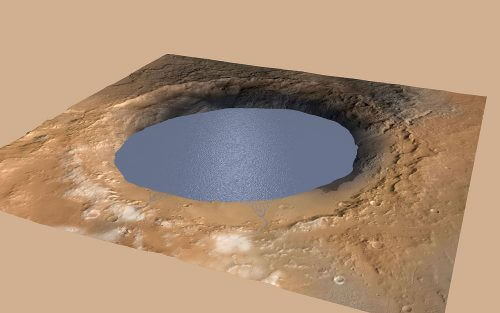An international team of researchers who were helped by Curiosity's findings compared it to a dry plain on the border of Bolivia and Peru, water that flows to it from the mountains drains into lakes that later dry up

Mars used to have salt lakes similar to those on Earth and had wet and dry periods. This is according to a study published by members of an international team of scientists.
Marion Nachon, from the Department of Geology and Geophysics at Texas A&M University, and her colleagues published their research in the current issue of Nature Geoscience.
The team examined the geological terrain of Mars from Gale Crater, a huge 95 km rocky basin that has been studied by NASA's Curiosity rover since 2012 as part of the MSL (Mars Labor Laboratory) mission.
The findings show that the lake that was in Gale Crater over three billion years ago went through a drying episode, possibly related to the global drying of Mars. Gale Crater was formed about 3.6 billion years ago when a meteor hit Mars and created its large impact crater.
"Since then, its geological layers have documented the history of Mars, and studies have shown that Gale Crater reveals signs of having liquid water on it during its history. As we know, water is a key component of microbial life," Nachun said. "During these drying periods, salt ponds were eventually formed. It's hard to say exactly how big these pools were, but the lake in Gale Crater has existed for long periods of time - from at least hundreds of years to perhaps tens of thousands of years," she said.

What happened to these salt lakes?
According to Nachon, Mars likely dried out over time, and the planet lost its planetary magnetic field, leaving the atmosphere vulnerable to stripping by solar wind and radiation over millions of years.
"As the atmosphere thinned, the pressure on the surface became smaller, and the conditions for liquid water to be stable on the surface were no longer met," Nachun said, "so the liquid water evaporated and disappeared." According to the assessment, the salt pools on Mars are similar to those found on Earth, especially in the area called Altiplano which is near the Bolivia-Peru border.
Nachon said the Altiplano is a high-altitude arid plain where the rivers and streams coming down from the mountains "do not flow to the sea but lead to closed lakes, similar to what used to happen in Gale Crater on Mars," she said. "This hydrology creates lakes with water levels that have been greatly affected by climate. During the arid periods, Altiplano lakes become shallow due to evaporation, and some even dry up completely. "The fact that the Atalifano is an area devoid of vegetation makes it look even more like Mars," she said.
Nachon added that the study shows that the ancient lake in Gale Crater went through at least one episode of drying before "recovering". It is also possible that the lake was divided into separate pools and these evaporated more easily. Because only one area on Mars that shows such a drying history has been studied so far, Nachon said it may give clues to how many drying episodes the lake went through before the Martian climate became as dry as it is now.
"This could indicate that the Martian climate 'dried out' in the long term, in a way that still allowed for a lake cycle," Nachon said. "These results indicate that the Martian climate fluctuates between wetter and drier periods. They also tell us about the types of chemical elements (in this case sulfur, a key ingredient for life) that were available in the liquid water found on the surface over time, and about the type of environmental fluctuations that life on Mars would have had to deal with, if they ever existed."
To the announcement of the researchers:
for scientific research
More of the topic in Hayadan:

4 תגובות
Correction of a typo - Mars Science Laboratory, and not as written in the third paragraph.
In view of all the knowledge that has been accumulated so far, and certainly Yosef Nigdal, what is the point of investing huge capital in plans for manned missions
to Mars when the essence of the research is
In fact, an understanding that already exists: what happened to it? It is clear to any reasonable person that the fate of the Earth may be similar to that of Mars, not because we did not fly to Mars
And not because we didn't put a human foot on it. Why not invest in emergency plans (no less) in huge capital investments
Without limits.. to understand what is only here in our small house located in such a hostile neighborhood, and what can be what is not and will not be on Mars and nowhere else in the universe.
Life appeared exclusively on the surface of the earth in the entire solar system because only there exist all the many conditions for existence of life, such as: correct distance from the sun (not too big and not too small, i.e. an average temperature of 20-15 degrees Celsius on its surface) ; Diameter and mass large enough to maintain an atmosphere with a thickness of about 165 km; the presence of a lot of water on its surface; Magnetic poles that repel the sun's deadly cosmic rays. Therefore, we have the duty to keep the planet Earth in our home by all necessary means so that we do not pollute the air and water and thus bring upon ourselves a completely unnecessary burden.
What really maybe we will finally have a solution to the housing problem